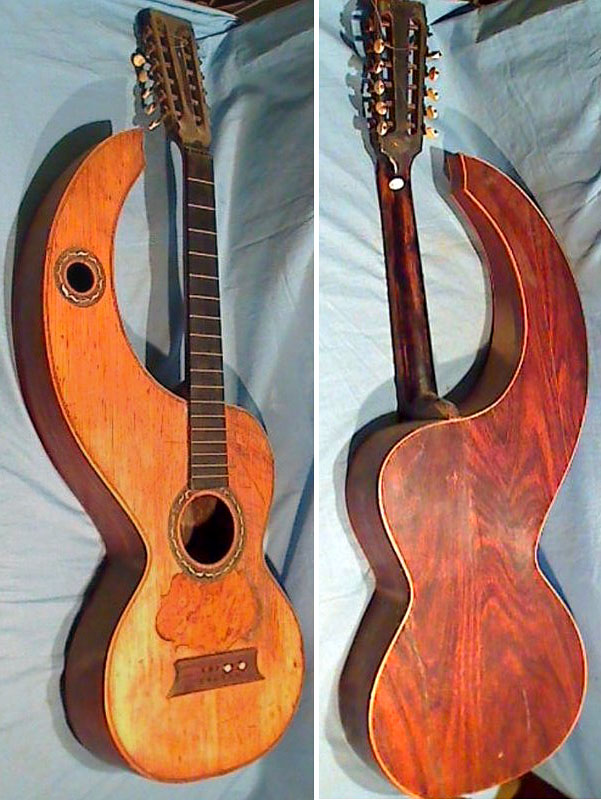There are plenty of instruments that people often confuse with harp guitars, perhaps none more so than 6-string guitars of the hollow arm variety. Readers are already familiar with many such instruments in the Hollow-arm Guitars Gallery, which I long ago grouped into three main types: (single-arm, dual arm, and continuous arm).
Here are a few new interesting models and specimens that have come to light in the last couple of years:

This 12-string guitar with its hollow arm connected firmly (if on a somewhat meandering path) to the headstock is from Alajuela, Costa Rica, date unknown. The maker’s name reads “Leonardo Brenes R.” It looks like a clone of one that’s been on the site from the beginning, owned by Charlie Faege (remember him?), built in Columbia (“c. 1950”). I think the pink sparkle pickguard helps, don’t you?

Here’s another that has long been on the site – also a 12-string, but with a terminated hollow arm. This is a slightly better photo, from owner (and seller) Sid Glickman. The shape of the missing pickguard makes me think Italian, but who knows. That bridge looks suspicious.

OK, I love this one. The builder provided two different opportunities for this to become a harp guitar, yet it remains a 6-string! Again, I’m thinking Italian. It was kindly submitted by a fellow named Paul Quinn.
I think that gets me up to date with single hollow arm 6-string guitar discoveries.
Next, we have a few new double-arm forms, which naturally are sometimes called “Lyre Guitars.” I’d probably call that them myself, though always with the caveat of pointing out their obvious differences from the original 100-year earlier table-standing forms. Where those late 1700’s instruments were really a new creation unto themselves, these later instruments (perhaps borrowing similar elements) were adapted from the standard American guitars of their day – just highly exaggerated!

Ignoring their obvious different historical, cultural and musical repertoire differences, one can still tell at a glance how the later (mostly) American lyre guitars differ visually. They have the rounded bottoms of standard guitars – rather than the flat, table-standing bottoms of French-style lyre guitars – and they have also retained their standard guitar “waists.” To my untrained “I don’t know art, but I know what I like” eye, the table-standing forms (having no waist) often reach aesthetic perfection, while the American forms only achieve a fascinating, if ungainly, state of phantasmagoria (compared at left).
Check it out:

As Richard Johnston pointed out during his Antiques Roadshow analysis of this wonderful instrument by F. Gaulke (no date or location), these American lyre guitars probably came about for the same reason as harp guitars – the quest for more volume (and of course, American ingenuity and over-the-top creativity). Thus, the builders similarly added hollow arms for potentially additional tone and volume like Knutsens and Dyers (choosing two arms for symmetry), but eschewed the extra strings. This Gaulke instrument is finely made, with cello binding – so Richard naturally thought it was a rare guitar attempt by a good violin maker. In a few rare cases (and thus of great interest to me) there were additional “harp” versions of American lyre guitars like the well-known Washburn:
This next one is not so fine, but still shows plenty of ingenuity. I can’t quite make out all the carving on the headstock attachment, but each side features a staff of musical notation.

It’s owned by Tom Galbraith, who told me “This guitar belonged to my dad Art Galbraith who was an Ozarks fiddler, instrument trader and repairman. He bought this guitar from a descendant of the maker in the 1940s. Dad had a cousin who had bought a similar instrument from the same person.” The maker added (or replaced) a typed label reading “THIS HARP GUITAR MADE IN 1891 BY FARNHOLM BROTHERS. REBUILT 1931 BY C. FARNHOLM THE PIANO TUNER. NO OTHER INSTRUMENT MADE IN THE WORLD LIKE IT.” This is not the first time that someone gets lyre guitars and harp guitars mixed up. Pretty enterprising, though – those Farnholm brothers must have been a hoot!
![]()
In this undated photograph (a recent eBay offering I lost out on), a gentleman holds a nice 1900’s lyre guitar that’s something of a cross between the two above.
And finally, we jump a few decades to the ‘Fifties, and the infamous “Lyric Behee Harp Guitar” (another inventor apparently confused between harps and lyres). This is an unusual 8-string (double-course) tenor guitar version, offered on eBay a couple of years back.
While looking through my files and email correspondence, and again on the web, I realized that there are now quite a number of instruments and stories about the Behees from all manner of sources, including family members of the builder(s) and players. So, in short order, I’ll try to prepare another detailed blog on this interesting and increasingly well-known non-harp “Harp Guitar.”









So what value could you put on such an instrument, I would think a lot more then Richard quoted. If for no other reason but the age . I have been repairing guitars for forty years now and never saw anything like that . Very interesting no.